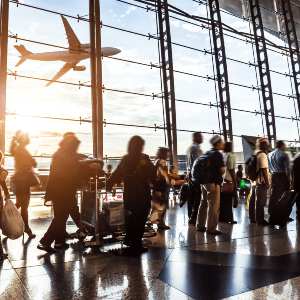I have to confess, I have had a bad experience in a hotel lift on more than one occasion.
One time I got into a hotel lift in a leading 4-star hotel in Chiang Rai, Thailand to get to my room on the 3rd floor. The lift suddenly stopped and the lights went out. There was no emergency lighting and the intercom system and the alarm bell where not functioning because the electricity was down in the whole area and the hotel had no backup generator. I banged against the door and yelled for help, but no one heard me. Mobile phones also did not work. It took the management over 45 minutes to wake up to the fact that one of their lifts was stuck between two levels. Caught in a lift like that can be a little disconcerting, particular when you have no communication with the outside world and you do not know when help will arrive.
But even after an experience like that, I can still say that, overall, hotel lifts are safe. In fact lifts are among the safest means of transport there is, even though they travel up to 10 meters per second. Cable borne lifts are extremely safe. In the last 60 years, only once (in 2012 in Thailand) did an elevator drop in a free fall, killing a woman. Statistically this number of deaths is seen as very low when the number of lifts and journeys per year are calculated.
Factor in that there are millions of lifts worldwide and those taking lifts are not most at risk. Workers doing maintenance work and those involved in rescue training face greater risks, with 20 to 30 people involved in these activities killed in lift-shaft accidents each year.
Why lifts are safe
Don’t believe the many elevator free falls you see in Hollywood movies. A lift going into free fall is very unlikely. Manufacturers have built in effective safety measures. For instance, to mitigate the risk of a free fall of a lift car, Schindler Lifts ensure that each cable can carry 12-16 times more then the official weight allowed in the lift. Sometimes lift cars hang on up to 10 of these cables. In the unlikely event a cable (or cables) ever breaks, a special safety break system will stop the lift car immediately. Other manufacturers have similar standards of safety.
Technology to the rescue
Some hotels are using modern security card readers, intercom systems, and emergency call buttons to elevate lift safety and convenience when a malfunction occurs and the elevator becomes stuck between floors. Hotel lifts can also be equipped with CCTV cameras and modern IP-technology, allowing a 2-way communication with guests in the lift car.
Modern IP intercom systems, for example, are suitable for lifts that offer input and output communication with the lift car as well as integration with access control and building and security management systems. Combined with third party cable extenders, modules ensure IP over Cat5/6 or Ethernet over VDSL2 communication, resulting in an IP intercom solution. This allows communication to run through microphone/s and speaker/s in the existing lift control panel and lift cars. An IP audio and video intercom system will also enhance the security in the hotel. Integration with access control is a valuable feature, especially for incidences that occur at night.
This is all a bit technical, but it shows the extent of effort being made by hotels to provide safety and convenience for lift users.
Lifts and natural disasters
So how do lift manufacturers help ensure user safety during a natural catastrophe such as an earthquake? In earthquake-prone regions, Otis, for example, offers special seismic sensors to maximize passenger safety. When the seismic sensor detects an earthquake, if the car is moving it stops at the nearest floor and the door opens automatically. If the lift is occupied, but not moving and the door is closed, it will open automatically and any guests inside can exit.
Stuck lifts – the biggest concern
The biggest concern for hotels regarding elevator safety is the time it takes to for those trapped be rescued. My 45-minute experience alone in a dark lift in Thailand was not pleasant. Those who stress in an enclosed space or in the dark would find such a delay quite difficult to handle. It is even scarier when faced alone without any communication. In my case, the hotel relied on an external rescue team and they took quite some time to arrive.
Blackouts are an issue
I was trapped in the lift in Thailand because of a general power blackout in the area. Countries in Asia and in parts of Europe and Africa live with frequent power outages. In this case, the hotel did not have emergency power backup and also were relying on an external rescue service, so I was left to sit and wait for 45 uncomfortable minutes.
Some rescue services promise to be on site within 30 minutes. It is a guideline, but sometimes not realistic.? Depending on how long the power is out, management needs to consider that rescue services will be stretched in their efforts to manage the large volume of emergency calls and attend to emergencies that arise in the general area and may not get to the hotel as quickly as management would like. Therefore, rescue procedures need to be in place so hotel staff can deal with this situation.
What hotels should include in emergency procedures regarding lifts
My experience shows why it is so important that hotels ensure their key staff are trained to safely manage an emergency situation during a blackout. In the event emergency service professionals cannot quickly attend lift rescues, it is important hotel staff across all shifts are trained in lift rescue. In my example above, the hotel did not follow standard operating procedures and did not check all elevators immediately after the power was out. This scenario does happen quite often in hotels around the world.
No communication with the people who are trapped is a poor quality standard and grossly negligent that can lead to expensive compensation charges in some countries.
Instill confidence in your lifts
They are still many people who are afraid to take the lift. To make guests feel more confident about stepping in the elevators at your property, there are several things you can do.
First, I think the general appearance of the lift gives guests a projection of how well elevators are maintained. People also judge whether it is a safe elevator by the look of the interior design, the smell, the ventilation, the ceiling height, light & music effects, and if the lift is vibrating. Putting elevators with higher ceilings into hotels with giant doors seems to be the latest trend. These lifts provide more comfort and make you feel safer compared to small lifts where you are squeezed in with many other passengers thinking you have to hold your breath until you arrive on your floor.
For those who are still afraid that a lift can make a free fall, signs or posters in the lift car stating how unlikely it is that a free fall can happen can help guests feel more comfortable. Even displaying when the emergency systems was last tested (Like a tick of approval QA system) can give the guest more confidence and a better feeling. This is what the hotel business is all about.
About the author
His hotel experience includes rooms division management, pre-opening, fire, health & safety, risk management & cost control. He has worked for leading hotel brands in Munich, Frankfurt, Bremen, Berlin, Cork, Edinburgh and Doha in the Middle East.
He graduated in 2002 as a Hotel Management Consultant at the Steigenberger Hotel Management School. He gained valuable experience as a Cost Controller at the Sheraton Hotel & Towers at Frankfurt Airport. He worked three years in Ireland where he built on his experience as a former volunteer fire officer and became a qualified IOSH Health & Safety Officer. He effectively combined the field of Health & Safety with his Assistant Manager positions.
Stefan now consults to hotels to implement innovative and affordable strategies to raise their level of security to meet growing global demands.

















